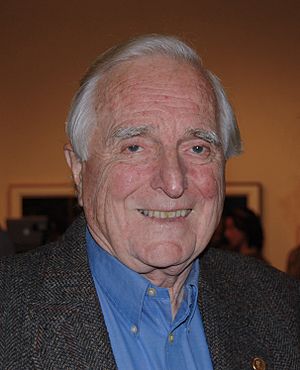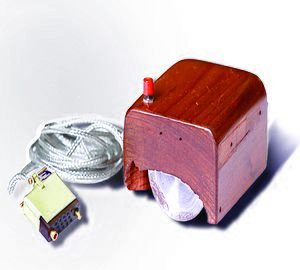The Mother of All Demos facts for kids
The "Mother of All Demos" is the nickname for a famous computer presentation given by Douglas Engelbart on December 9, 1968. This event happened in San Francisco at a big computer conference. Engelbart showed off a new computer system called NLS (oN-Line System).
This 90-minute live show was the first time many important parts of modern computers were seen together. These included windows on a screen, hypertext (like links on the internet), computer graphics, and easy ways to use commands. It also showed video calls, the computer mouse, and word processing. Engelbart's presentation was the first to publicly show all these features working in one system. This demonstration was very important and led to similar projects at Xerox PARC in the 1970s. The ideas and technology from this demo influenced the Apple Macintosh and Microsoft Windows operating systems later on.
Contents
Why it's Called the "Mother of All Demos"
The name "Mother of All Demos" was first used by journalist Steven Levy in his 1994 book. He described the event as amazing and groundbreaking. The phrase "mother of all..." became popular after Saddam Hussein used "mother of all battles" before the 1991 Gulf War. Andries van Dam, who was at the demo, also used this phrase later.
The Idea Behind the Demo
Douglas Engelbart's ideas for his Augmentation Research Center (ARC) and the NLS system came from thinking about how to manage knowledge better. He was inspired by an article called "As We May Think" by Vannevar Bush. Engelbart believed that computers could do more than just calculate numbers. He thought they could help people think and work better.
He saw that new technologies sometimes had unexpected problems. For example, fast food production could harm the soil. This made him think that society needed better ways to handle scientific knowledge. He realized that computers could make the human mind more powerful.
The Famous Demonstration
Engelbart gathered a team of engineers and programmers at the Stanford Research Institute (SRI) in the early 1960s. His goal was to make computers tools for communication and finding information, not just for math. He wanted to bring Vannevar Bush's idea of a "Memex" machine to life. This machine would help one person use a computer to "augment" or increase their intelligence.
For six years, with money from NASA and ARPA, his team built all the parts needed for this computer system. The director of ARPA, Robert Taylor, encouraged them to show NLS to the public. So, the first public demonstration happened at the 1968 Fall Joint Computer Conference. It took place in San Francisco at the Bill Graham Civic Auditorium.
The presentation was called "A research center for augmenting human intellect." About 1,000 computer experts watched the show. Many important people in computing were there, like Alan Kay and Andries van Dam.
Engelbart, with his team, showed how NLS worked. Bill English managed the technical side of the presentation. They used a special video projector to show the computer screen on a huge 6.7-meter (22-foot) tall screen. This let everyone in the audience see what Engelbart was doing.
The researchers also made two special, fast modems for 1968. These modems sent data from the keyboard and mouse at the auditorium to their main computer in Menlo Park. To have live video calls between the lab and the conference hall, they used two microwave links.
During the 90-minute presentation, Engelbart used his mouse to move around the screen. He highlighted text and changed the size of windows. This was the first time an all-in-one system for working with text on a screen was shown publicly.
At different times, his team members Jeff Rulifson and Bill Paxton appeared on another part of the screen. They helped edit text from their lab far away. They could see each other's screens, talk, and see each other. Engelbart also showed that clicking on underlined text would open another page of information. This was the idea of hypertext.
When the demonstration finished, the audience gave him a standing ovation. A separate room was set up so people could try the NLS workstations and ask Engelbart questions.
How it Changed Computing

Before the demo, some computer scientists thought Engelbart's ideas were strange. But after he finished, people were amazed. Andries van Dam was working on a similar system. He was shocked to see how advanced NLS was. He said the NLS demo was the greatest thing he had ever seen. Van Dam later became a leader in teaching computer graphics.
However, the immediate impact on the wider computer field was small. Many people were still using older computer systems. But the demo did spark interest in a small group of researchers.
In the 1970s, many of Engelbart's team members left ARC. Many of them went to the Xerox Palo Alto Research Center (PARC). Bill English went there and helped make the computer mouse even better. Robert Taylor, who had supported Engelbart, also moved to PARC. Alan Kay, who saw the demo, designed a new computer environment called Smalltalk at PARC.
By 1973, the Xerox Alto was a working personal computer. It was much smaller than the NLS system. The Alto had a mouse and a graphical user interface (GUI). This influenced Steve Jobs and Apple's Macintosh computer in the 1980s. Later, Microsoft's Windows operating system also used a mouse and a GUI, similar to the Alto and NLS.
Engelbart's influence grew over time. He became known as the inventor of the mouse and hypertext. On the demo's 30th anniversary in 1998, Stanford University held a big conference. They celebrated Engelbart's amazing vision for computing and the World Wide Web. By the 40th anniversary, Engelbart's demo was recognized as one of the most important events in computer history.
In 2015, a musical show called The Demo was created. It showed the event and was performed at Stanford.
See also
 In Spanish: The Mother of All Demos para niños
In Spanish: The Mother of All Demos para niños



